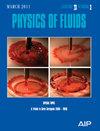Unsteady aerodynamic flow control at low Reynolds numbers via internal acoustic excitation
IF 4.1
2区 工程技术
Q1 MECHANICS
引用次数: 0
Abstract
Aerodynamic flow control using internal acoustic excitation holds promise as it combines the simplicity of passive flow control techniques (in terms of added weight and operational complexity) with the control authority of active flow control methods. While previous studies have analyzed the effects of acoustic excitation on steady-wing aerodynamics, the effect of excitation on the unsteady aerodynamics is not known, which is the aim of the current effort. Internally mounted speakers on a symmetric National Advisory Committee for Aeronautics (NACA) 0012 wing are used to excite the unsteady boundary layer at the wing's leading edge as it executes linear pitch motions ranging from quasi-steady (trailing-edge driven stall) to vortex-dominated (mixed leading- and trailing-edge driven stall) motions at freestream Reynolds numbers (Re) of 120 000 and 180 000. Experimental results show that, although acoustic excitation delays stall for quasi-steady motions, it enhances lift in the linear region and increases leading-edge vortex strength for vortex-dominated motions. The degree of change was observed to be a function of the excitation frequency, with lower frequencies (≤ 250 Hz) leading to an increase in aerodynamic efficiency and higher frequencies having a negligible effect. The current work establishes the effects of acoustic flow excitation in unsteady, low-Re wing aerodynamics and provides insights on the path forward to effectively implement the method for active flow control.通过内部声学激励实现低雷诺数下的非稳态气动流控制
利用内部声学激励进行气动流控制具有广阔的前景,因为它结合了被动流控制技术的简单性(在增加重量和操作复杂性方面)和主动流控制方法的控制权威性。虽然之前的研究已经分析了声激励对稳定翼空气动力学的影响,但还不知道激励对非稳定空气动力学的影响,而这正是当前研究的目标。在自由流雷诺数 (Re) 为 120,000 和 180,000 时,对称国家航空咨询委员会 (NACA) 0012 机翼上的内部安装扬声器用于激励机翼前缘的非稳态边界层,该边界层执行从准稳定(后缘驱动失速)到涡流主导(前缘和后缘混合驱动失速)的线性俯仰运动。实验结果表明,虽然声激励延迟了准稳定运动的失速,但增强了线性区域的升力,并增加了涡流主导运动的前缘涡流强度。据观察,变化程度是激励频率的函数,频率越低(≤ 250 Hz),气动效率越高,频率越高,影响越小。目前的工作确定了声流激励在非稳态、低铼机翼空气动力学中的效果,并为有效实施主动流控制方法的前进道路提供了启示。
本文章由计算机程序翻译,如有差异,请以英文原文为准。
求助全文
约1分钟内获得全文
求助全文
来源期刊

Physics of Fluids
物理-力学
CiteScore
6.50
自引率
41.30%
发文量
2063
审稿时长
2.6 months
期刊介绍:
Physics of Fluids (PoF) is a preeminent journal devoted to publishing original theoretical, computational, and experimental contributions to the understanding of the dynamics of gases, liquids, and complex or multiphase fluids. Topics published in PoF are diverse and reflect the most important subjects in fluid dynamics, including, but not limited to:
-Acoustics
-Aerospace and aeronautical flow
-Astrophysical flow
-Biofluid mechanics
-Cavitation and cavitating flows
-Combustion flows
-Complex fluids
-Compressible flow
-Computational fluid dynamics
-Contact lines
-Continuum mechanics
-Convection
-Cryogenic flow
-Droplets
-Electrical and magnetic effects in fluid flow
-Foam, bubble, and film mechanics
-Flow control
-Flow instability and transition
-Flow orientation and anisotropy
-Flows with other transport phenomena
-Flows with complex boundary conditions
-Flow visualization
-Fluid mechanics
-Fluid physical properties
-Fluid–structure interactions
-Free surface flows
-Geophysical flow
-Interfacial flow
-Knudsen flow
-Laminar flow
-Liquid crystals
-Mathematics of fluids
-Micro- and nanofluid mechanics
-Mixing
-Molecular theory
-Nanofluidics
-Particulate, multiphase, and granular flow
-Processing flows
-Relativistic fluid mechanics
-Rotating flows
-Shock wave phenomena
-Soft matter
-Stratified flows
-Supercritical fluids
-Superfluidity
-Thermodynamics of flow systems
-Transonic flow
-Turbulent flow
-Viscous and non-Newtonian flow
-Viscoelasticity
-Vortex dynamics
-Waves
 求助内容:
求助内容: 应助结果提醒方式:
应助结果提醒方式:


